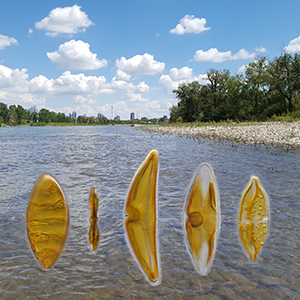Exploring diatom diversity through cultures - a case study from the Bow River, Canada

Accepted: 18 November 2022
HTML: 11
All claims expressed in this article are solely those of the authors and do not necessarily represent those of their affiliated organizations, or those of the publisher, the editors and the reviewers. Any product that may be evaluated in this article or claim that may be made by its manufacturer is not guaranteed or endorsed by the publisher.
Authors
Diatom cultures can help answer taxonomic, biogeographic and ecological questions on a local and global scale. Unialgal cultures are derived from a single cell and provide abundant material for morphological and molecular analyses. The link between the historic morphological species concept and the molecular data is becoming increasingly important with the use of eDNA metabarcoding. Additionally, cultures provide insights into the life cycle of diatoms and thereby complement taxonomy and species ecology. In this study, we present an approach to extract benthic diatoms from an environmental sample to generate unialgal cultures. We explored diatom diversity in preserved assemblages and by culturing as many different taxa as possible from benthic freshwater samples taken on the same day from the Bow River in Calgary, Canada. With both methods we found a total of 221 different benthic diatom taxa, of which 182 were identified in the preserved diatom assemblages. Interestingly, an additional 39 taxa only appeared in the cultures. In total 129 strains were cultivated representing 71 different taxa. This study includes pictures of living cells demonstrating the additional merits of unialgal cultures, as they provide information on plastid details, auxospores and endosymbionts. Both, the identification of the diatom assemblages and the generation and identification of strains provide the foundation for additional water quality assessment tools, taxonomic insights and molecular references libraries.
Edited by
Francesca Bona, Department of Life Sciences and Systems Biology, University of Turin, ItalySupporting Agencies
Verein der Freunde des Botanischen Gartens und Botanischen Museums Berlin Dahlem e.V. , Federal Ministry of Education and Research (German Barcode of Life 2 Diatoms, GBOL2)How to Cite

This work is licensed under a Creative Commons Attribution-NonCommercial 4.0 International License.
Similar Articles
- Soumi Nandi, Gautam Aditya, Goutam K. Saha, Nutrient conditions and chironomid productivity in Kolkata, India: assessment for biomonitoring and ecological management , Journal of Limnology: Vol. 71 No. 2 (2012)
- Tomasz Mieczan, Małgorzata Adamczuk, Monika Tarkowska-Kukuryk, Dorota Nawrot, Effect of water chemistry on zooplanktonic and microbial communities across freshwater ecotones in different macrophyte-dominated shallow lakes , Journal of Limnology: Vol. 75 No. 2 (2016)
- Stefan Sommer, Sarma Nandini, S.S.S. Sarma, Arpat Ozgul, Diego Fontaneto, Rotifers in Lake Orta: a potential ecological and evolutionary model system , Journal of Limnology: Vol. 75 No. s2 (2016): Lake Orta: a new lease on life
- Lei Zhang, Qianjiahua Liao, Chao Zeng, Qiongli Mo, Chengxin Fan, Effects of pretreatment on the sequential phosphorus fractionation of anaerobic sediment , Journal of Limnology: Vol. 73 No. 2 (2014)
- Enlou Zhang, Yanmin Cao, Peter Langdon, Qian Wang, Ji Shen, Xiangdong Yang, Within-lake variability of subfossil chironomid assemblage in a large, deep subtropical lake (Lugu lake, southwest China) , Journal of Limnology: Vol. 72 No. 1 (2013)
- Antonio Bjørn Stefano Poléo, Birgitte Marie Kjelsberg, Nina Alstad Rukke, Leif Asbjørn Vøllestad, Rapid recovery of normal gill morphology and blood physiology in brown trout (Salmo trutta) after short-term exposure to toxic concentrations of aqueous aluminium under non-steady state chemical conditions , Journal of Limnology: Vol. 80 No. 2 (2021)
- Pál Boda, Arnold Móra, Zoltán Csabai, AMI-KMNP dataset: Occurrence records of aquatic macroinvertebrate species from a 10-year-long biodiversity survey in SE Hungary , Journal of Limnology: Vol. 82 No. s1 (2023): Georeferenced freshwater biodiversity data
- Marzia Ciampittiello, Helmi Saidi, Lyudmila Kamburska, Silvia Zaupa, Angela Boggero, Temporal evolution of lake level fluctuations under flood conditions and impacts on the littoral ecosystems , Journal of Limnology: Vol. 81 No. s2 (2022): Effects of water level management on lake littorals and downstream river areas
- Martha Patricia Celis-Salgado, Wendel (Bill) Keller, Norman D. Yan, Calcium and sodium as regulators of the recovery of four Daphnia species along a gradient of metal and base cations in metal contaminated lakes in Sudbury, Ontario, Canada , Journal of Limnology: Vol. 75 No. s2 (2016): Lake Orta: a new lease on life
- Anna A. Kasparson, Leonard V. Polishchuk, Seasonal variation in the relative strength of bottom-up vs top-down effects in pelagic cladoceran populations identified through contribution analysis of birth rate , Journal of Limnology: Vol. 82 (2023)
<< < 28 29 30 31 32 33 34 35 36 37 > >>
You may also start an advanced similarity search for this article.
-
Katherina Schimani, Nélida Abarca, Oliver Skibbe, Heba Mohamad, Regine Jahn, Wolf-Henning Kusber, Gabriela Laura Campana, Jonas ZimmermannMetabarcoding and Metagenomics : 2023

 https://doi.org/10.4081/jlimnol.2022.2095
https://doi.org/10.4081/jlimnol.2022.2095





